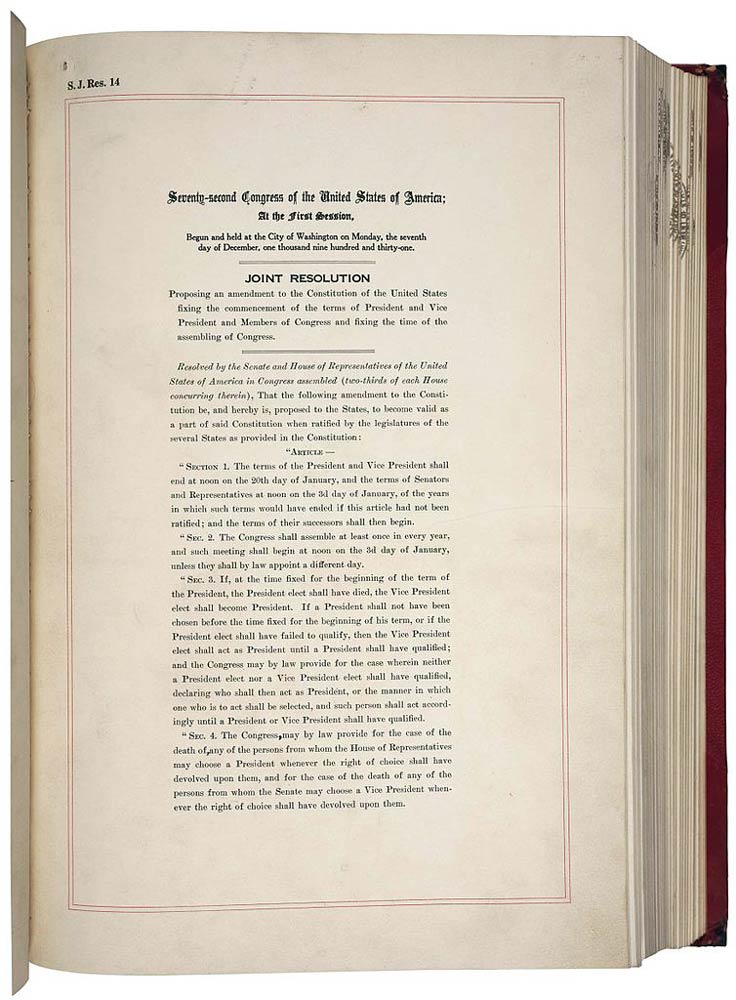| United States Constitution | |
|---|---|
 |
|
| The U.S. Constitution | |
| Preamble | |
| Articles of the Constitution | |
| I ‣ II ‣ III ‣ IV ‣ V ‣ VI ‣ VII | |
| Amendments to the Constitution | |
| Bill of Rights | |
| I ‣ II ‣ III ‣ IV ‣ V ‣ VI ‣ VII ‣ VIII ‣ IX ‣ X | |
| Additional Amendments | |
| XI ‣ XII ‣ XIII ‣ XIV ‣ XV ‣ XVI ‣ XVII ‣ XVIII ‣ XIX ‣ XX ‣ XXI ‣ XXII ‣ XXIII ‣ XXIV ‣ XXV ‣ XXVI ‣ XXVII | |
| View the Full Text | |
| Original Constitution | |
| Bill of Rights | |
| Additional Amendments |
On January 23, 1933, the 20th Amendment to the United States Constitution was ratified. This amendment set the guidelines on the beginning and ending of terms served by federal officials. According to the amendment, there is a need to change the start of terms designated to presidents, vice presidents and representatives of the country. With these changes, federal officials will be able to address significant national crises. It also pertains to the different scenarios that occur when there is no elected president in the country.
Text
Section 1. The terms of the President and Vice President shall end at noon on the 20th day of January, and the terms of Senators and Representatives at noon on the 3d day of January, of the years in which such terms would have ended if this article had not been ratified; and the terms of their successors shall then begin.
Section 2. The Congress shall assemble at least once in every year, and such meeting shall begin at noon on the 3d day of January, unless they shall by law appoint a different day.
Section 3. If, at the time fixed for the beginning of the term of the President, the President elect shall have died, the Vice President elect shall become President. If a President shall not have been chosen before the time fixed for the beginning of his term, or if the President elect shall have failed to qualify, then the Vice President elect shall act as President until a President shall have qualified; and the Congress may by law provide for the case wherein neither a President elect nor a Vice President elect shall have qualified, declaring who shall then act as President, or the manner in which one who is to act shall be selected, and such person shall act accordingly until a President or Vice President shall have qualified.
Section 4. The Congress may by law provide for the case of the death of any of the persons from whom the House of Representatives may choose a President whenever the right of choice shall have devolved upon them, and for the case of the death of any of the persons from whom the Senate may choose a Vice President whenever the right of choice shall have devolved upon them.
Section 5. Sections 1 and 2 shall take effect on the 15th day of October following the ratification of this article.
Section 6. This article shall be inoperative unless it shall have been ratified as an amendment to the Constitution by the legislatures of three-fourths of the several States within seven years from the date of its submission.
Summary
In the first section of the article, the terms served by the president and vice president of the country will end on the 20th day of January at noon. Moreover, the terms of all Congress representatives and senators will end on the 3rd day of January, also at noon. Then, the terms of all successors to these positions will begin.
Section 2 of the article states that the U.S. Congress will convene once per year, and the meeting is set to begin on the 3rd of January. There are exceptions, though, particularly when they appoint by law on a different day.
The third section explained further the terms served by the U.S. President. In case the elected President died while in office, the Vice-president would assume the vacant position. Furthermore, the Vice-president would become the head of the country if the elected president failed to qualify for his or her post.
Further Details
 Section 1 of the 20th Amendment shortened the length of time that existed between the day of election and the start of the presidential, congressional, and vice presidential terms. The terms served by the President originally began on the 4th day of March, which is about 4 months after Election Day. Although the said term was a practical necessity, it was no longer effective in this modern age since it effected the functioning of the government.
Section 1 of the 20th Amendment shortened the length of time that existed between the day of election and the start of the presidential, congressional, and vice presidential terms. The terms served by the President originally began on the 4th day of March, which is about 4 months after Election Day. Although the said term was a practical necessity, it was no longer effective in this modern age since it effected the functioning of the government.
During the 19th century onward, this translates to a lame duck Presidential or Congressional administration that may fail to respond promptly to the pending national crisis. For instance, a lame duck administration or Congress may not have the time or power to tackle certain issues, and the incoming administration will have the time and electoral mandate to determine and address these concerns of the entire nation. The problems are likely to be the center of any debate of the completed election cycle.
This dilemma was observed to be quite significant in the years 1861 and 1933, which were after the presidential elections of Lincoln and Roosevelt, as well as the newly-elected representatives and senators. At that time, the Constitution stated that the presidents were obliged to wait for about four months before they could deal formally with national issues such as the Great Depression and secession of the Southern States. Hence, these problems remained unsolved because of the lack of power and authority held by the newly-elected government officials.
In the original article, which was under Section 4 and Clause 2, the U.S. Congress was responsible for meeting at least once in a year, specifically on the 1st Monday of December. This policy has resulted to a mandatory “lame duck” session that followed federal elections. In the second Section of the 20th Amendment, the date for convening was changed to January 3.
Impact
The changes made in section 5 of the Twentieth Amendment were made effective on October 15, 1933. According to historians, the delay led to the 73rd Congress’ first meeting, which was alongside the inauguration of the newly-elected President Franklin Roosevelt and Vice President John Garner.
On February 15, 1933, twenty-three days after the ratification of the amendment, President Roosevelt became the target of several failed assassination attempts by Giuseppe Zangara. In case the attempt had become successful back then, Vice President John Garner would have assumed the position as President in place of President Franklin Roosevelt on March 4, 1933.
On January 3, 1935, the initial congressional terms began under section 1 of the 20th Amendment. Furthermore, the terms assigned to the president and vice president began on January 20, 1937. With the passing of the Amendment, the incoming Congress would choose the best person to occupy any unresolved offices, in case the Electoral College failed to resolve these concerns.